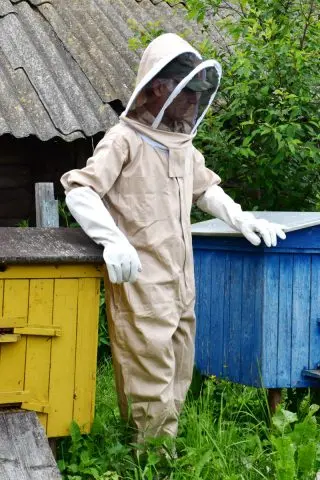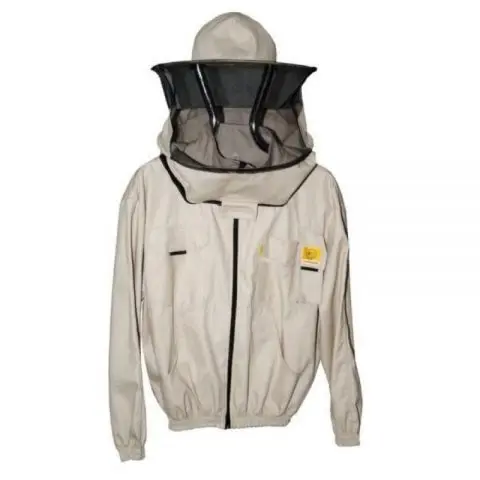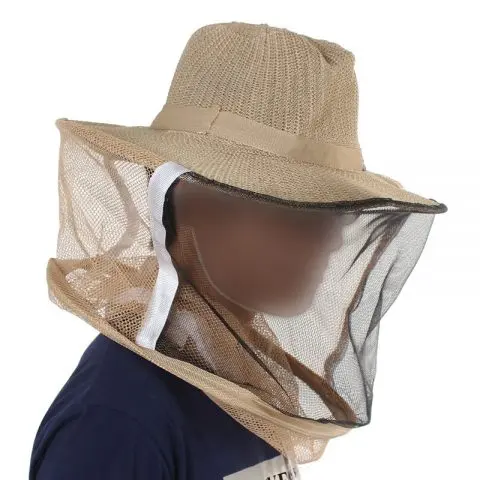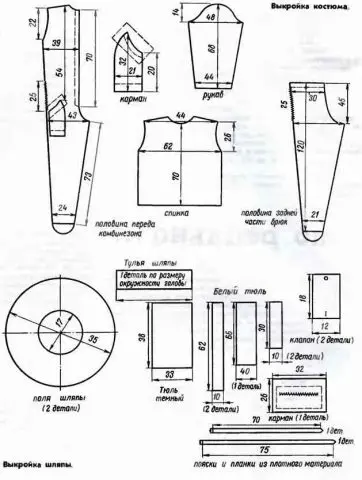Contents
A beekeeper’s suit is a necessary attribute of equipment for working with bees in an apiary. It protects against attacks and insect bites. The main requirement for special clothing is its complete set and convenience during work. Not the last role is played by the composition of the material and the quality of tailoring.
What are the requirements for beekeeping suits
Specialized stores offer a large selection of beekeeping clothing with different configurations. When working in the apiary, the suit must be functional in nature, covering open parts of the body. The main object of insect bites are the head and hands, they must be protected first. The standard set consists of a mask, gloves, overalls or a jacket with trousers. You can wear any clothes, the main thing is that there is no access for bees. Gloves and a hat with a mesh for a beekeeper are a must.
Beekeepers give preference to a ready-made, fully equipped set. You can choose a suit of any color, the main thing is that it is in size, does not restrict movement, and is made of high-quality material. Basic requirements for beekeeper clothing:
- The color scheme of the material from which the suit is sewn is not used in calm pastel colors, brightly colored or black fabrics. Bees distinguish colors, bright colors cause irritation and aggression of insects. The best option is a white or light blue suit.
- The lining should be made of natural fabric that provides good thermoregulation. The main work in the apiary is carried out in summer in sunny weather, the beekeeper’s skin should not overheat.
- The fabric should not let moisture through. This criterion is especially important if the summer is rainy and it is necessary to work with the swarm. In waterproof clothing, the beekeeper will feel comfortable.
- To prevent clothing from catching fire when using a smoker, choose a fire-resistant material.
- The fabric is smooth, lint-free, so that the bees do not catch on the surface of the suit and do not sting during its removal. It is impossible to work in woolen or knitted clothes; folds and pockets are not recommended on a suit from bees.
- The material must be durable to provide maximum protection.
Complete set of a protective suit of the beekeeper
The necessary complete set of overalls for work in the apiary is selected taking into account the type of bred bees. There are several breeds of insects that do not show aggression when invading the hive. In this case, a mask and gloves will suffice, as a rule, the beekeeper does not use a smoker. The main types of insects are quite aggressive, a complete set is needed to work with them. The photo shows a standard beekeeper’s suit.

Overalls
Overalls beekeeper – the best option when choosing overalls for the apiary. The fabric for sewing a one-piece attribute is used dense from natural fiber. Basically it is a linen fabric woven from double threads. A zipper is sewn in front along the entire length of the torso. It provides tightness, insects will not get to the open body under the clasp of clothing. For protection, the cuffs of the sleeves and trousers are elasticated, with its help the fabric fits snugly around the wrists and ankles. The elastic is inserted at the level of the waist on the back. There are several options for the costume, in many the cut takes into account the presence of a mask. It is attached to the collar with a zipper, in front it is fixed with Velcro. When removing clothes, the mask folds back like a hood. Overalls are purchased 1 or 2 sizes larger than regular clothes so that they do not restrict movement during work.

Jacket
If the beekeeper is experienced, has studied the habits of insects well, a beekeeper’s jacket can become an alternative to overalls. If the breed of bees does not show aggression, the jacket is used on a hot sunny day, when the bulk of the swarm is occupied in the honey collection. Sew clothes from light natural fabric, chintz, satin white, or light beige. The jacket is equipped with a front zipper or can be without a zipper. An elastic band is inserted along the bottom of the product and the sleeves. The collar is standing, when closing the zipper, it fits snugly to the neck or is tightened with a cord. The cut of the clothes is loose, not tight.
Hat
If the beekeeper does not use a standard overall or jacket, then a beekeeper’s hat is necessary. This is a wide-brimmed hat. A beekeeper’s hat is made from fine linen or cotton fabric. In summer, the beekeeper will not be hot in it during work, the size of the fields will protect the eyes from the sun. A fabric mesh is fixed along the edge of the headdress or only on the front side. The bottom of the mesh is tightened in the neck area.

Mask
The beekeeper’s mask protects the head, face and neck from insect bites. Facial meshes come in a variety of options. The most popular designs among beekeepers:
- Mask «Len» European standard is made of linen fabric. Two plastic rings are sewn into it at the top and at the base of the shoulders. A beige tulle mesh with an average mesh size is stretched over them. The veil is inserted not only from the side of the front part, but also on the sides, this design provides a large viewing area.
- classic mask, made from natural material. Two metal rings are inserted, providing a good stretch. The veil is sewn in a circle, covering the back and front. The lower ring rests on the shoulders. The mesh is tightened around the neck. In the classic version, black tulle with small cells is used.
- Mask “Coton”. It is sewn from cotton fabric with inserted rings. The top ring acts as a brim for a hat. A black veil is inserted only from the front side. Sides and back are fabric.

Gloves
Gloves are included in the standard set of the costume. The main bee stings occur on open areas of the hands. They produce special beekeeper gloves made of thin leather material or its synthetic substitute. The professional cut of protective clothing provides for a high bell with an elastic band at the end. The length of the sleeve comes to the elbow. If there is no special protection, hands protect:
- canvas gloves;
- economic from rubber;
- medical.
Household knitted gloves are not suitable for working in the apiary. They have a large weave, a bee can easily sting through them. If a professional protective equipment is replaced by an improvised one, it is necessary to ensure that the insect does not penetrate into the area of the sleeves.
How to choose a beekeeper’s clothes
The beekeeper’s suit should be one size larger than normal clothes so as not to create discomfort during work. Clothing must meet hygiene and safety requirements. The main task of overalls is protection from insect bites. You can purchase a ready-made kit or make a beekeeper’s suit according to a pattern with your own hands.
For work in the apiary, overalls of the European standard are offered. There are a variety of options in the trading network, the “Improved” beekeeper’s suit, sewn from dense double-thread linen fabric, is in high demand. The kit includes:
- Jacket with a zipper, with a large front pocket with a zipper and a smaller side pocket with Velcro. Pockets fit snugly. The cuffs and bottom of the product are elasticated.
- Protective mesh fastened with a zipper in the collar area.
- Trousers with two velcro pockets and elasticated hem.
Popular among beekeepers is the Australian beekeeper suit. Overalls are produced in two versions, overalls and deuce (jacket, trousers). The suit is made of modern fabric “Greta”. The uniqueness of the material is that the polyester thread is located on top, and the cotton thread is on the bottom. The fabric is hygienic, waterproof, flame retardant. Ribbed cuffs on sleeves and trousers. Three voluminous Velcro pockets are sewn on: one on the jacket, two on the trousers. A mesh in the form of a hood, two hoops are sewn into it, the front part of the veil is zipped in a circle. The design is very convenient, at any time the beekeeper can open his face.
How to sew a beekeeper costume with your own hands
You can sew a suit for work in the apiary yourself. To do this, acquire a fabric made from natural fibers: coarse calico, cotton, linen. Color white or light beige. The cut is taken taking into account that the product will be two sizes larger than ordinary clothes. You will need a zipper from the neck to the groin and an elastic band, if it goes on a jacket and trousers, measure the volume of the hips, multiply by 2, add the cuffs of the sleeves and trousers. Sew a beekeeper’s suit with your own hands.

The drawing shows a pattern of overalls, a separate suit is made according to the same principle, only divided into two parts, the elastic is inserted into the trousers and the bottom of the jacket.
DIY beekeeper mask
You can make your own mask for working with bees. To do this, you need a hat made of light material, fabric or straw is suitable. Necessarily with wide, hard fields so that the grid does not touch the face. You can take it without borders, then you need a metal hoop made of thick wire. First, a hoop is sewn into the tulle, leaving a supply of fabric on top, necessary to secure it to the hat. Sew the design without gaps, which will prevent the penetration of insects. The mesh gets black, a mosquito is suitable. Step-by-step recommendation for making protection using a hat:
- Measure the hat along the edges of the brim.
- Cut the tulle 2 cm longer (launch on the seam).
- Sew with small stitches.
The length of the mesh is taken taking into account allowances for a loose fit on the shoulders. A cord is sewn along the edge to fix it around the neck.
Conclusion
The beekeeper’s suit is chosen at your discretion. Standard complete set of overalls: mask, jacket, trousers, gloves. Overalls are considered the safest for work. The main requirement for equipment is protection from bee stings.









